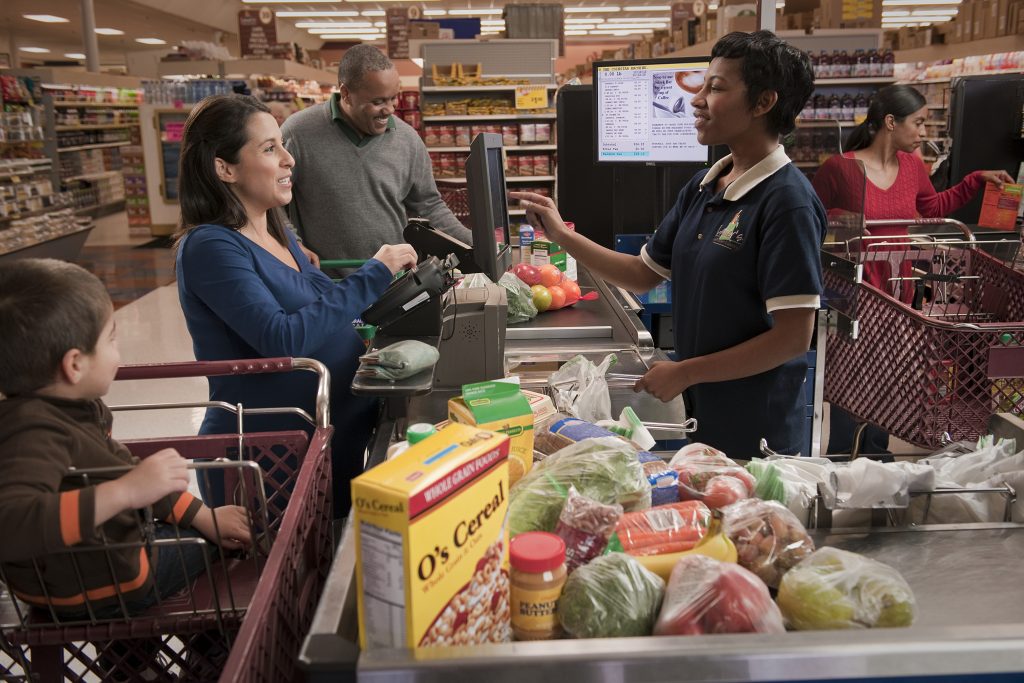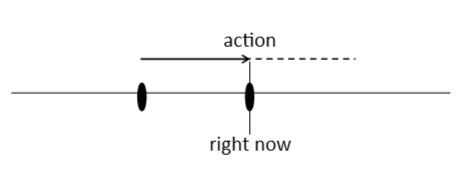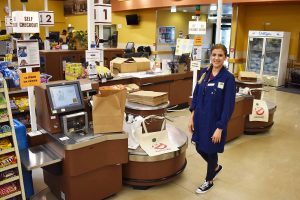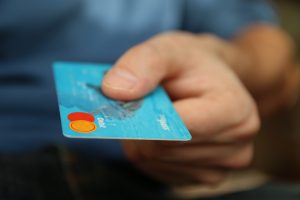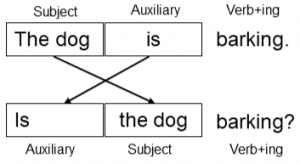Chapter 2: Present Progressive
Shopping for Food
 Learning Goals
Learning Goals
At the end of this chapter you should be able to:
Recognize and use the present progressive:
- in the affirmative and negative
- with contractions
- with yes/no questions and short answers
- with information questions using appropriate wh-question words
- with time expressions
- with the correct spelling
 Prepare
Prepare
Activity 2.1: Prereading
Activity 2.2: Prereading
Directions: Discuss the following questions with a partner.
1. Where do you go grocery shopping?
2. How often do you go grocery shopping?
3. What do you buy at the grocery store?
4. How do you get to the grocery store? Do you walk, go by car, or by bus?
 Read
Read
Directions: Read this story out loud with a partner. One person reads a paragraph, then the other person reads the next paragraph. When you are finished, read the story again. This time, read the paragraphs you did not read.
Viktor and Tatiana Are Grocery Shopping
Viktor and Tatiana are from Ukraine. They are married. They are students at Clackamas Community College, and they are taking ESL classes this term. They are studying English, so they can get jobs. They are not working now.
Today, they need* to go to the grocery store. Right now, it is 3:00 pm. They are walking to the grocery store. It is raining hard. Viktor is holding an umbrella, so they are not getting wet.
It is now 3:15 pm. They are shopping for food and talking about their English classes. Tatiana remembers, “Oh! We need* pencils and paper.” Viktor says, “I want* some erasers, too.”
Now, at 3:45 pm, they are waiting in line at checkout. The man at the front of the line is writing a check. He is not paying cash. The baby in the cart behind them is crying.
At 3:55 pm, it is their turn. They are buying food and school supplies. A young man is putting their groceries in paper bags. Tatiana is paying with cash. The cashier is giving them change and the receipt.
It is 4:00 pm now. They are walking home. At this moment, it is not raining, and the sun is shining. They are smiling.
 *Some verbs like “need” and “want” are called stative verbs. They show a state of being, not an action. Stative verbs are not used in the progressive tenses. You will learn more about stative verbs in Chapter 4.
*Some verbs like “need” and “want” are called stative verbs. They show a state of being, not an action. Stative verbs are not used in the progressive tenses. You will learn more about stative verbs in Chapter 4.Activity 2.3: Comprehension
Directions: Answer the questions about the story.
1. Where are Viktor and Tatiana from? (Use the BE verb)
___________________________________________________________________
2. Are they working this term? (choose one)
Yes, they are. No, they aren’t.
3. What are they studying?
___________________________________________________________________
4. What are they doing at 3:00 pm?
___________________________________________________________________
5. What is the weather like?
___________________________________________________________________
6. Are they getting wet? (choose one)
Yes, they are. No, they aren’t.
7. What does Tatiana remember?
___________________________________________________________________
8. What are they doing at 3:45 pm?
___________________________________________________________________
9. Is the man paying cash? (chose one)
Yes, he is. No, he isn’t.
10. What are Viktor and Tatiana doing at 4:00 pm?
___________________________________________________________________
 Explore
Explore
Activity 2.4: Noticing
Directions: Read the story again. choose (by underlining or otherwise marking) all uses of the present progressive. Then, write three of the verbs used in the story below.
Remember
Example
Activity 2.5: Try It Out!
Directions: Write three sentences using the verbs you found.
1. _________________________________________________________________
2. _________________________________________________________________
3. _________________________________________________________________
Discover
Uses of the Present Progressive
The present progressive is used to talk about an action or situation that is in progress and happening right now. It started in the past and is probably going to continue into the future. We often use time expressions (signal words) to show this: right now, at the/this moment, now.
Example
I am learning grammar right now.
It is happening at this moment.
It also shows an action or situation that is continuing for a long period around the present time. There are many expressions that show this: this week, this month, this year, this term.
Example
I am taking English classes this term.
It is happening for an extended period of time.
The present progressive is also used to describe a change or temporary action.
Example
I usually drive to school. This week, I am taking the bus.
Notice that the simple present is used to talk about a habit/routine. The present progressive shows that there is a temporary change.
Time Expressions: Signals Words Used with the Present Progressive
We use time expressions to signal the time that the action is happening. Sometimes we call time expressions signal words.
Examples
- at the/this moment
- now
- right now
- this week/term/month
At this moment, I am washing the dishes.
My husband is watching a football game right now.
Forms of the Present Progressive
The present progressive is formed by an auxiliary (helping) verb and the main verb. The BE verb is the auxiliary for progressive tenses. It agrees with the subject (the person or thing that performs or completes the action of the verb; the “do-er”) and tells us that we are talking about the present time. The main verb changes by adding -ing to it. The -ing form of the main verb is called the present participle.
To form the present progressive tense, you need two parts of the verb:
auxiliary BE (am, is, are) + present participle (verb+ing)
| Auxiliary (Helping) Verb (BE) | Present Participle: Main Verb + -ing |
|---|---|
| am | writing |
| is | sleeping |
| are | watching |
Activity 2.6: Writing
Directions: Write three 3 sentences using the verbs in the table above and a time expression.
1. _________________________________________________________________
2. _________________________________________________________________
3. _________________________________________________________________
Spelling: Present Participle
Spelling in English can be difficult, but there are some rules to follow when forming the present participle.
Rule 1: If the base verb ends in a consonant + 1 vowel + consonant (CVC), double the consonant before adding -ing: hit → hitting. If there are two vowels between the consonants, do NOT double the last consonant: rain → raining.
| Base Verb | Present Participle |
|---|---|
| hit | hitting |
| plan | planning |
| run | running |
| stop | stopping |
| swim | swimming |
Rule 2: NEVER double the consonants w, x, or y (e.g., playing). The n is usually not doubled when verbs end in -en (e.g., happening).
Rule 3: If the base verb ends in an -e, remove it before adding -ing.
| Base Verb | Present Participle |
|---|---|
| come | coming |
| ride | riding |
| dance | dancing |
| write | writing |
| leave | leaving |
Activity 2.7: Complete the Table
Directions: Change the base verbs to the present participle. Use the spelling rules to help you.
| Base Verb | Present Participle |
|---|---|
| take | 1. |
| study | 2. |
| get | 3. |
| wait | 4. |
| give | 5. |
| listen | 6. |
| sit | 7. |
| pay | 8. |
| shop | 9. |
| make | 10. |
Activity 2.8: Fill-in-the-Blank
Part 1 Directions: Complete the sentences with the correct form of the present progressive. Be sure and spell the verbs correctly as described above.
Remember
Viktor and Tatiana are new to the United States. They are students at Clackamas Community College. They (1. take)_____________________ ESL classes this term. They (2. study)_____________________ English, so they can get jobs. They love their classes. Right now, they (3. walk)_____________________ to the grocery store. It (4. rain) _____________________ hard, so Viktor (5. hold)_____________________ the umbrella to keep them dry.
Part 2 Directions: Now go back and choose (by underlining or otherwise marking) the time expressions. There are two.
Activity 2.9: Writing
Directions: Think about what you are doing right now. Work with a partner to write three sentences using the present progressive and time expressions. Every sentence should have a time expression. Check your spelling when you are done.
1. _________________________________________________________________
2. _________________________________________________________________
3. _________________________________________________________________
 Affirmative in the Present Progressive
Affirmative in the Present Progressive
As noted above, we use the present progressive to talk about things happening now or around this time (extended time). The affirmative tense form is the BE verb + the present participle
subject + BE + present participle
| Subject | Auxiliary BE | Present Participle |
|---|---|---|
| I | am | shopping. |
| He/She/It | is | shopping. |
| You/We/They | are | shopping. |
Activity 2.10: Complete the Table
| Subject | Auxiliary BE | Present Participle |
|---|---|---|
| 1. | am | learning. (learn) |
| 2. He | is | (work) |
| 3. She | walking. (walk) | |
| 4. | is | raining. (rain) |
| 5. You | are | (read) |
| 6. We | sitting. (sit) | |
| 7. | are | running. (run) |
Affirmative Contractions in the Present Progressive
Contractions in the present progressive are formed just as we learned in Chapter 1. They are very common in spoken English.
| Subject | Auxiliary BE | Present Participle |
|---|---|---|
| I'm | shopping. | |
| He's She's It's |
||
| You're We're They're |
||
Activity 2.11: Writing
Activity 2.12: Writing
Directions: Look at the pictures. Then, answer the questions using the words given to you. Change the verb to the present progressive. Use full forms for odd numbers and contractions for even numbers.
1. What is the man doing?
he / make a grocery list
_______________________________________________________
_______________________________________________________
2. What is the man doing?
he / buy vegetables
_______________________________________________________
_______________________________________________________
3. What is the woman doing?
she / look at pineapples
_______________________________________________________
_______________________________________________________
4. What is the man doing?
he / compare prices
_______________________________________________________
_______________________________________________________
5. What is the woman doing?
she / wait for customers
_______________________________________________________
_______________________________________________________
6. What is the man doing?
he / pay with a debit card
_______________________________________________________
_______________________________________________________
7. What is the man doing?
he / check his grocery list
_______________________________________________________
_______________________________________________________
8. What are the people doing?
they / shop at the farmer’s market
_______________________________________________________
_______________________________________________________
9. What is the cashier doing?
she / smile at customers
_______________________________________________________
_______________________________________________________
10. What is the man doing?
he / walk down the aisle
_______________________________________________________
_______________________________________________________
Activity 2.13: Fill-in-the-Blank
Directions: Complete the sentences with the present progressive form of the verb in parentheses.
1. My son (come) _____________________________________home from school now.
2. Right now, I (write)____________________________________ this sentence.
3. At the moment, my wife (sit)________________________________ on the sofa.
4. They (buy)__________________________________ groceries at the market now.
5. This term, we (study)__________________________ the present progressive tense.
6. The girl (do)_____________________________ her homework in the living room.
7. You (think)___________________________about grammar as you do this exercise.
8. The people at this party (wear)_____________________________ beautiful clothes.
9. He (sing)______________________________________ a song in the shower now.
10. This year, my son (play)______________________________________ the violin.
11. The woman (feed)_____________________________________________ her cat.
12. They (give)___________________________________ a reward to the brave man.
13. The boys (draw)_______________________________ pictures in their notebooks.
14. I (carry)_____________________________________ my books to class right now.
15. It (rain)_______________________________________ very hard at the moment.
16. We (listen)_________________________________________ to the radio right now.
17. You (answer)_______________________________________ these questions now.
18. The dog (chew)__________________________________________ a shoe now.
19. The boy’s mother (feel)_____________________________________ sick today.
20. The students (buy)____________________________________ paper this week.
Adapted from: "ESL for Beginning Students: The Way You Like It Basic Beginning Grammar/Writing (Part One of Two)" by Don Bissonnette, licensed under CC BY-NC 4
 Negative Statements in the Present Progressive
Negative Statements in the Present Progressive
To make a sentence negative with the present progressive, add not between the auxiliary verb (BE) and the present participle (main verb + ing).
subject + auxiliary BE + not + present participle
| Subject | Auxiliary BE | Not | Present Participle |
|---|---|---|---|
| I | am | not | shopping. |
| He She (It) |
is | ||
| You We They |
are |
Activity 2.14: Complete the Table
Directions: Complete the table. Write the correct verb form for the negative sentences.
Remember:
| Subject | am not / is not / are not | Rest of Sentence |
|---|---|---|
| I | watching TV right now. | |
| You | ||
| She | ||
| We | ||
| They |
Activity 2.15: Writing
Directions: Change the affirmative statements to the negative by adding not.
1. Viktor is working.
___________________________________________________________________
2. Tatiana is learning Japanese.
___________________________________________________________________
3. It is raining.
___________________________________________________________________
4. They are buying a TV.
___________________________________________________________________
5. The sun is shining.
___________________________________________________________________
6. Tatiana is paying with a debit card.
___________________________________________________________________
Negative Contractions in the Present Progressive
| Subject | Auxiliary BE | Not | Present Participle |
|---|---|---|---|
| I'm | not | shopping. | |
| He's She's (It's) |
|||
| He She (It) |
isn't | ||
| You’re We’re They’re |
not | ||
| You We They |
aren't | ||
Activity 2.16: Writing
Directions: Answer the following questions in the negative. Use complete sentences. Use contractions.
Example
1. Are you riding the bus right now?
___________________________________________________________________
2. Is he taking 5 classes this term?
___________________________________________________________________
3. Are they waiting at the restaurant now?
___________________________________________________________________
4. Is it snowing in Portland today?
___________________________________________________________________
5. Are you biting an apple now?
___________________________________________________________________
6. Is class beginning right now?
___________________________________________________________________
7. Am I driving my car right now?
___________________________________________________________________
8. Are we going to the movies today?
___________________________________________________________________
9. Is Chela feeding her cats right now?
___________________________________________________________________
10. Is the sun shining in Milwaukie today?
___________________________________________________________________
Adapted/Source: "ESL for Beginning Students: The Way You Like It Basic Beginning Grammar/Writing (Part One of Two)" by Don Bissonnette is licensed under CC BY-NC 4.0
 Yes/No Questions & Short Answers
Yes/No Questions & Short Answers
Remember
The subject and the verb change places in questions. The auxiliary verb comes first!
| Auxiliary BE | Subject | Present Participle | Short Answers |
|---|---|---|---|
| Am | I | shopping? | Yes, you are. No, I’m not. |
| Is | he she (it) |
shopping? | Yes, he is. No, he’s not. |
| Are | you we they |
shopping? | Yes, they are. No, they’re not. |
Activity 2.17: Fill-in-the-Blank
Example
Are you feeling (feel) OK? No, I’m not.
1. _______ _______ _______ (go) to the grocery store? No, _______ _______.
2. _______ _______ _______ (take) English classes? Yes, _______ _______.
3. _______ _______ _______ (feed) the dog? No, _______ _______.
4. _______ _______ _______ (do) homework? Yes, _______ _______.
5. _______ _______ _______ (eat) at home? No, _______ _______.
6. _______ _______ _______ (drive) to the market? Yes, _______ _______.
7. _______ _______ _______ (watch) a movie? No, _______ _______.
8. _______ _______ _______ (make) dinner? Yes, _______ _______.
9. _______ _______ _______ (buy) a ticket? No, _______ _______.
10. _______ _______ _______ (pay) with cash? Yes, _______ _______.
 Activity 2.18: Game
Activity 2.18: Game
Information Questions in the Present Progressive
The formation of information questions is the same as yes/no questions. Add the question word (e.g. who, where, what, why, when, how) to the beginning of the question.
wh- + auxiliary BE + subject + present participle
| Wh- Question Word | Auxiliary BE |
Subject | Present Participle |
|---|---|---|---|
| Why | am | I | shopping? |
| Where | is | he she (it) |
shopping? |
| When | are | you we they |
shopping? |
Activity 2.19: Listening
Directions: Your instructor is going to read some questions. Write what you hear on the lines.
1. ________________________________________________________________
2. ________________________________________________________________
3. _________________________________________________________ a nap?
4. _____________________________________________________ to school?
5. _________________________________________________________ home?
6. ________________________________________________________________
Activity 2.20: Fill-in-the-Blank
Directions: Read the phone conversations between Viktor and Tatiana. Look at the answer and the words in parentheses to complete the questions. Don’t forget to add a question
mark (?) at the end. When you are done, practice the dialogues with your partner.
Conversation 1:
Tatiana: (what / you / do)
______________________________________________________
Viktor: I’m cutting out coupons.
Tatiana: (why / you / cut out coupons)
______________________________________________________
Viktor: I want to save money at the grocery store.
Conversation 2:
Viktor: (what / you / do)
______________________________________________________
Tatiana: I’m making dinner.
Viktor: (what / you / make)
______________________________________________________
Tatiana: I’m making cabbage soup.
Viktor: Great! I’m hungry!
Conversation 3:
Viktor: (what / you / do)
______________________________________________________
Tatiana: I’m studying.
Viktor: (where / you / study)
______________________________________________________
Tatiana: I’m studying at the library right now.
 Review
Review
Activity 2.21: Listening
Directions: Read the paragraph. Then, listen to your instructor read the paragraph. Listen for the missing words. Write the missing words on the lines.
Ana and Pedro want to have a picnic. They (1)____________________ to a nice park by the river. They (2)____________________ the warm weather today. Now, they (3)______________ a blanket on the grass to sit on. Also, they (4)____________________ the food on the blanket. A few minutes later, Pedro (5)____________________ photos with his phone. Ana asks, “Why (6)____________________ so many photos?” “I (7)____________________ them to Mom. She misses us,” he replies. “Yes, I miss her, too,” says Ana. They (8)____________________ to music, and they (9)____________________ about their mom’s cooking.
Activity 2.22: Error Correction
Directions: There are 8 mistakes in the paragraph below. Find the mistakes with the present progressive and correct them. The mistakes can be missing verb parts, word order, or verb agreement.
Remember
My name is Carlos. Right now I sitting in class. I am learn about grammar. The teacher talk about the present progressive. She is not talk about the simple present. Maria and Lourdes listening. Why Tan’s cell phone is ringing? Outside, a few students is playing soccer. Mohammad watch them.
Activity 2.23: Fill-in-the-Blank
Directions: Fill in the present progressive verb form for each sentence or question.
1. We (study)___________________________________________ grammar this quarter.
2. My son (not drive)_______________________________ to the supermarket right now.
3. It (rain)___________________________________________________________ now.
4. The boy and his friends (walk)_____________________ to the store to buy some milk.
5. I (not listen)________________________________________ to the radio at this time.
6. My daughters (not take)_________________________________ guitar lessons today.
7. I (not plant)_____________________________________ tomatoes in my garden now.
8. The sun (shine)___________________________________________________ today.
9. Students (learn)____________________________ the present progressive tense now.
10. (look)_______________________ she __________________________ for her key?
11. How (do)___________________________ they ______________________?
12. (cook)________________ we ___________________ for twelve or fourteen people?
13. What (make)___________________ you ____________________ for dinner tonight?
14. Where (study)_____________ the student ________________ today?
15. The baseball player (not play)_____________________________ in the game today.
16. The boy and girl (not help)____________________________ their mom clean today.
17. (watch)___________________ you ______________________ television right now?
18. Why (eat)________________________ he ________________________ right now?
19. (look)_________________ the students _____________________ at them right now?
20. He (work)_______________________________________________________ now.
Adapted/Source: "ESL for Beginning Students: The Way You Like It Basic Beginning Grammar/Writing (Part One of Two)" by Don Bissonnette is licensed under CC BY-NC 4.0
 Write
Write
Directions: Write a paragraph about your morning activities using the present progressive tense.
Format:
- Use your own 8.5" x 11" lined paper. Do not use other paper sizes, please.
- Heading: Put your full name, the due date, and Chapter 2 Writing Assignment at the top of your paper. Your instructor will tell you where the heading goes (left or right side).
- Indent the first sentence, skip lines (double space), and leave a 1-inch margin on the sides and bottom.
Writing and Grammar:
- First sentence: Begin writing by using this topic sentence: It is morning, and I am doing many things.
- Imagine that it is morning time. Write a paragraph about things you are doing and things you are not doing in the morning.
- Write 5 affirmative sentences using the present progressive.
- Write 5 negative sentences using the present progressive.
- Use full forms; do not use contractions.
- Use capital letters and punctuation correctly.
- Use the rubric below to check your work.
Assignment Rubric:
| Heading: Full Name, Due Date, and Ch. 2 Writing Assignment | 1 point |
| Format: Indent, double space, margins | 1 point |
| Every sentence has a subject and verb & they agree | 1 point |
| There are 5 affirmative sentences using the present progressive | 5 points |
| There are 5 negative sentences using the present progressive | 5 points |
| Correct use of spelling | 1 point |
| Correct use of capital letters | 1 point |
| Correct end punctuation | 1 point |
| Total points | 16 |
Model Paragraph:
My Morning Activities
It is morning and I am doing many things. I am drinking coffee. I am not drinking tea. I am watching the news. I am taking a shower. I am getting dressed. I am not ironing my clothes. I am cooking breakfast. Now I am washing the breakfast dishes. I am not washing the car. I am leaving for work. I am not going to the gym. I am not taking a vacation.
 Self-Assessment
Self-Assessment
These were our goals at the beginning of Chapter 2:
Recognize and use the present progressive:
-
- in the affirmative and negative
- with contractions
- with yes/no questions and short answers
- with information questions using appropriate wh-question words
- with time expressions
- with the correct spelling
Directions: Choose “yes” or “no” in the table below if you think you have achieved the goals. Write an example of the goal in the last column.
| I can... | I achieved this goal: | My example: |
|---|---|---|
| write affirmative sentences. | yes
no |
I am studying. |
| write negative sentences. | yes
no |
|
| use contractions. | yes
no |
|
| write yes/no questions. | yes
no |
|
| answer yes/no questions using short answers. | yes
no |
|
| write information questions using wh- question words. | yes
no |
|
| use time expressions. | yes
no |
|
| use correct spelling. | yes
no |


